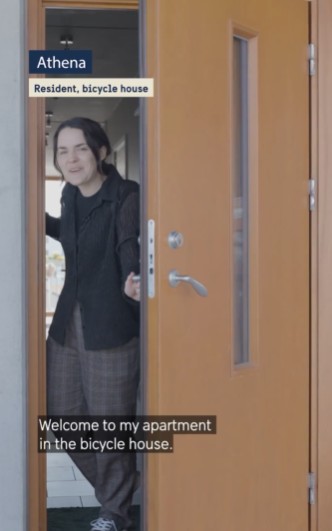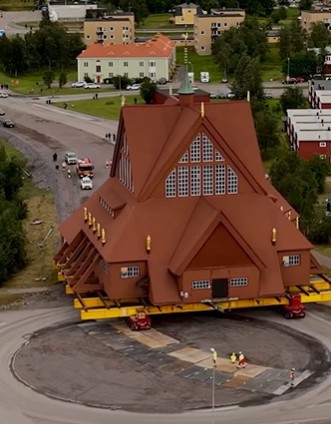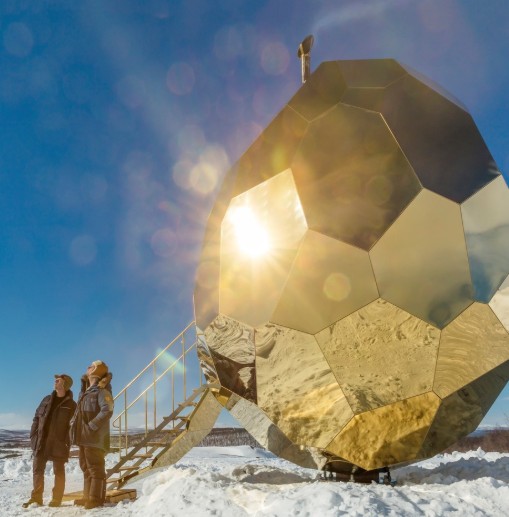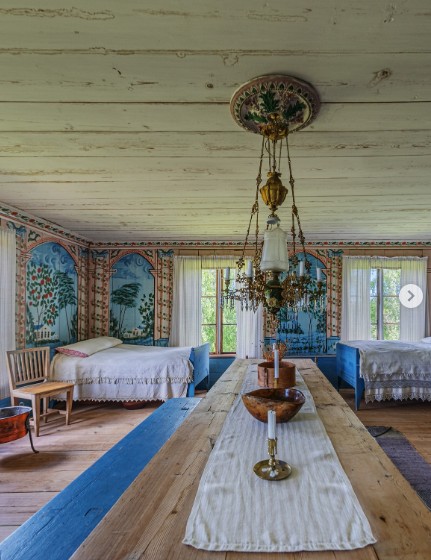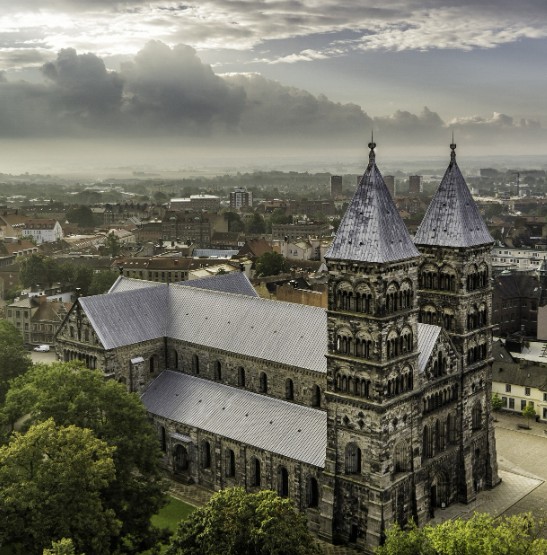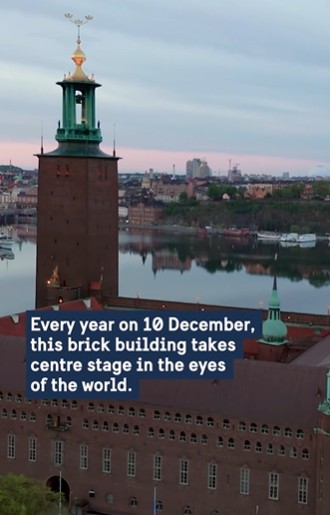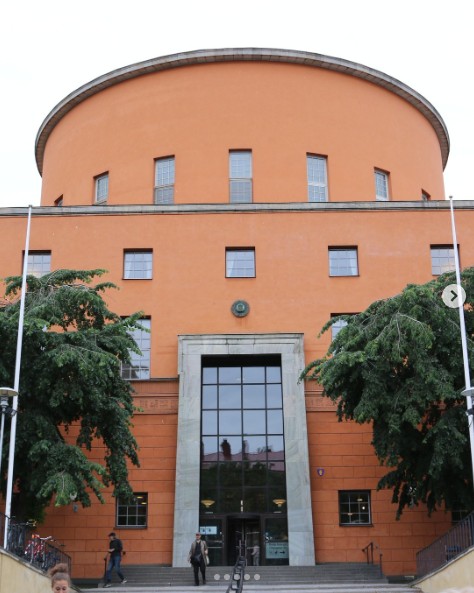Swedish architecture
Discover 25 examples of Swedish architecture – steeped in tradition, looking to the future.
1. Wisdome
Wisdome, a 'science theatre' at Sweden's National Museum of Science and Technology, is a prize-winning building designed by Elding Oscarson. Its curved wooden roof spans 48 metres and is completely self-supporting. The construction comprises 20 kilometres of laminated veneer lumber (LVL) boards and 120,000 pieces of pine on the shingle roof.
2. Turning Torso
Malmö’s Turning Torso, designed by Santiago Calatrava, is the world’s first twisting skyscraper and Scandinavia’s second tallest tower at 190 metres. Located in the Western Harbour, Västra hamnen, it dominates the Malmö skyline.
3. Kiruna church
Gustav Wickman’s Kiruna church from 1912 has been voted Sweden’s most beloved building of all time. This red wooden church has a unique design – almost square and with four rooftop points facing four different directions. Another unique thing about it, is that the church will be moved! Due to extensive mining, the whole church was moved to a new location in August 2025 (see video). In fact, a large part of the city of Kiruna is moving for the same reason, to its new home three kilometres east of the old town.
4. The Electron Microscope, aka Ångströmhuset
Ångströmhuset, Europe’s most precise electron microscope is an instrument so sensitive to vibrations, sounds and electromagnetic fields that it needs a building of its own. And it's covered with Titanitum plates. Tham & Widegård's architecture boldly stands out among offices and classrooms on the campus of Linköping University.
5. Eslöv civic hall
Sweden’s arguably most extravagant civic hall, Medborgarhuset, is located in the small, southern town of Eslöv. Completed in 1957, the building was young architect Hans Asplund's first major project. He carefully chose the materials for the deluxe civic hall – without regard for either price or technique. Criticised at first, people now consider the material and aesthetic quality of the civic hall a high watermark of detailed, expressive and spatially rich civic architecture.
6. The Solar Egg sauna
The Solar Egg is quite a remarkable sauna! Originally built for Kiruna in the north of Sweden, it has travelled the world. After it's been dismantled, it takes around four to five days to reassemble.
7. The Öresund bridge
The Öresund Bridge – with a structure encompassing a tunnel and an artificial island – connects Sweden with Denmark and was designed by COWI. It's the world's longest cable-tied road and rail bridge, finished in August 1999. It won the IABSE Outstanding Structure Award in 2002.
8. Treehotel
The Mirrorcube is one of the half-dozen havens of contemporary architecture that is Treehotel, way up in Harads in the north of Sweden. Renowned Swedish architects Tham & Videgård, Cyrén & Cyrén, Inredningsgruppen and Sandell Sandberg have all worked on the buildings.
9. Restaurang Tusen – a birch hut restaurant
Murman Arkitekter’s Restaurang Tusen, built in 2008 in the family-owned ski resort of Ramundberget, serves up local and Sami food. The building stands in harmony with nature and is made of birch – the only local tree that grows up to the altitude where the building is located. And that's at 1,000 metres above sea level – hence Tusen (=thousand).
10. Kunskapshuset education centre
Gällivare in northern Sweden is aiming to become a 'world-class Arctic small town'. Kunskapshuset – designed by architecture firms Tengbom and Liljewall – is part of these efforts. It's an education centre that houses the local gymnasium, basically the equivalent of American high school, as well as adult education. The building has won several prizes.
11. The Icehotel
The world’s first Icehotel lies in Jukkasjärvi, 200 kilometres north of the Arctic Circle, and was founded in 1989. New artists and ice experts create the rooms anew in October–December each year. The hotel, consisting of 1,000 tonnes of ice and 30,000 m³ of snice (snow and ice), takes three months to melt and return to Mother Nature every spring. One part of the icy hotel (Icehotel 365) is open all year round thanks to solar energy keeping the ice cool enough.
12. Vallhamra suburban square
Vallhamra torg (link in Swedish) outside Gothenburg is where city planners and architects have come together to give new life to an older, out-of-date suburban square from the 1960s. The area hadn't quite kept up with the growing population and people's new lifestyles and demands, so now the square features new homes, shops and other services and communications.
13. The Decorated Farmhouses of Hälsingland
The Swedish province of Hälsingland is famous for its decorated farmhouses, Hälsingegårdar – some dating back to the 17th century. Seven of these houses are on the UNESCO World Heritage List.
14. The 'Glass Vase' office building
The office building of Glasvasen (link in Swedish), the 'Glass Vase', in Malmö is something of a green exclamation point with its undulating green glass façade. The building has been praised for its green approach – not because of its colour, though, but because of the holistic sustainable thinking behind it and the high sustainability standard of the construction.
15. Uppsala concert hall
Uppsala Konsert & Kongress, designed by Henning Larsen Architects, opened in 2007. Its reflecting metallic façade, reminiscent of piano keys, is an important gathering point in the historical student town that is Uppsala. The façade design reappears inside the building as well.
16. Lewerentz's flower kiosk
Sigurd Lewerentz’s brutalist flower kiosk from 1969, by the Eastern cemetery (Östra kyrkogården) in Malmö, is a much-debated icon of Swedish architecture. This is the renowned architect’s most scaled down and extreme building, mostly based on squares and golden sections. Debated as it may be, this example of Swedish architecture still attracts architecture buffs from all over the world.
17. Aula Medica
Wingårdhs’ Aula Medica rises above the traditional cottage – Stenbrottet (the stone quarry) from 1771 – blending old and new Swedish architecture. It was completed in 2013 for the medical university Karolinska Institutet, which selects the Nobel Prize laureates in Medicine or Physiology.
18. Lund Cathedral visitor centre
Carmen Izquierdo is the architect behind the Cathedral Forum (Domkyrkoforum, link in Swedish) the visitor centre at Lund Cathedral. The nearly thousand-year-old church receives about 700,000 visitors every year. The brass- and glass-clad visitor centre has an architectural lantern window that frames the cathedral like a painting when you look out through it. The building awarded Izquierdo the prestigious Kasper Salin Prize for outstanding architecture in 2012.
19. Avicii Arena
Avicii Arena (known as Globen) is named after late Swedish musician Avicii. It is one of the world’s largest spherical buildings and sticks up like a giant golf ball nestled between its residential surroundings. The arena, designed by Berg Arkitektkontor (now part of C.F. Møller), opened in 1989, has a diameter of 110 metres and a ceiling height of 85 metres.
20. Stockholm City Hall
Stockholm City Hall, Ragnar Östberg’s masterpiece of Swedish National Romanticism, was completed in 1923. A total of 365 steps lead up to its 106 metre tall bell tower, with a spire featuring the golden Three Crowns – Sweden’s national emblem. Since 2010, this example of classic Swedish architecture has been accompanied on its eastern side by White Arkitekter’s sustainable Stockholm Waterfront building.
21. Naturum Vattenriket – a nature centre
Naturum Vattenriket (roughly ‘the water realm visitor centre’) is situated in a wetlands reserve a five minute walk from the urban area of Kristianstad. The building acts as a reception between visitor and lakeside, while boardwalks offer the possibility to roam from city to nature and to explore the lake landscape from a variety of vertical perspectives. There are over 30 ‘naturums’ – visitor centres in nature reserves – in Sweden.
22. The nursing home Trädgårdarna
Trädgårdarna (‘the gardens’) is an nursing home in Örebro, a couple of hours west of Stockholm, that sets a new standard for future elderly care. Marge Arkitekter has been praised for really incorporating the perspective of the elderly in the building. As a result, the facility has a home-like feel to it while being very functional.
23. The Woodland Cemetery
A visit to the 100-hectare Woodland Cemetery (Skogskyrkogården), designed from 1920 and onwards by Gunnar Asplund and Sigurd Lewerentz, is a tragic and sublime journey through a beautifully rolling landscape of subtle romanticism. It’s probably also the most magical place in the world to spend All Saints’ Day, when candles are lit all over the cemetery. Sadly, Asplund himself was the first to be buried in his Woodland Crematorium. The simple stone plaque reads ‘His work lives’. Indeed.
24. Stockholm City Library
Stockholm City Library by Gunnar Asplund is famed for its round lending hall in the shape of a rotunda, with a ceiling height of 23 metres. Despite its relatively modest size, the building’s unique shape – a cylindrical central tower surrounded by three cubical wings – makes it feel monumental. In 2024 the library closed for renovations and it is planned to reopen in 2027
25. Triangeln railway station
With the Triangeln project in Malmö, engineer/architect/envirotech consultancy Sweco completed Sweden’s third busiest railway station six months early and 10 per cent under budget in 2010. Small on the outside, but spacious on the inside, the station plays an important role for the many Swedes and Danes who travel back and forth between the two countries.

